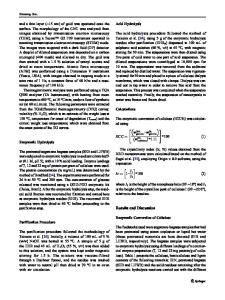The Feasibility of Producing Adequate Feedstock for Year-Round Cellulosic Ethanol Production in an Intensive Agricultura
- PDF / 4,071,025 Bytes
- 9 Pages / 595.276 x 790.866 pts Page_size
- 19 Downloads / 302 Views
The Feasibility of Producing Adequate Feedstock for Year-Round Cellulosic Ethanol Production in an Intensive Agricultural Fuelshed Daniel R. Uden & Rob B. Mitchell & Craig R. Allen & Qingfeng Guan & Tim D. McCoy
Published online: 22 March 2013 # Springer Science+Business Media New York 2013
Abstract To date, cellulosic ethanol production has not been commercialized in the United States. However, government mandates aimed at increasing second-generation biofuel production could spur exploratory development in the cellulosic ethanol industry. We conducted an in-depth analysis of the fuelshed surrounding a starch-based ethanol plant near York, Nebraska that has the potential for cellulosic ethanol production. To assess the feasibility of supplying adequate biomass for year-round cellulosic ethanol production from residual maize (Zea mays) stover and bioenergy switchgrass (Panicum virgatum) within a 40-km road network service area of the existing ethanol plant, we identified ∼14,000 ha of marginally productive cropland within the service area suitable for conversion from annual rowcrops to switchgrass and ∼132,000 ha of maize-enrolled cropland from which maize
stover could be collected. Annual maize stover and switchgrass biomass supplies within the 40-km service area could range between 429,000 and 752,000 metric tons (mT). Approximately 140–250 million liters (l) of cellulosic ethanol could be produced, rivaling the current 208 million l annual starch-based ethanol production capacity of the plant. We conclude that sufficient quantities of biomass could be produced from maize stover and switchgrass near the plant to support year-round cellulosic ethanol production at current feedstock yields, sustainable removal rates and bioconversion efficiencies. Modifying existing starch-based ethanol plants in intensive agricultural fuelsheds could increase ethanol output, return marginally productive cropland to perennial vegetation, and remove maize stover from productive cropland to meet feedstock demand.
D. R. Uden (*) Nebraska Cooperative Fish and Wildlife Research Unit, School of Natural Resources, University of Nebraska—Lincoln, 3310 Holdrege Street, Lincoln, NE 68583, USA e-mail: [email protected]
Keywords Switchgrass . Maize stover . Cellulosic ethanol . Biomass . Feasibility . Fuelshed
R. B. Mitchell USDA-ARS Grain, Forage and Bioenergy Research Unit, University of Nebraska—Lincoln, 130 Keim Hall, Lincoln, NE 68583, USA C. R. Allen US Geological Survey, Nebraska Cooperative Fish and Wildlife Research Unit, School of Natural Resources, University of Nebraska—Lincoln, 3310 Holdrege Street, Lincoln, NE 68583, USA Q. Guan Faculty of Information Engineering, China University of Geosciences (Wuhan), Wuhan, Hubei 430074, China T. D. McCoy Nebraska Game and Parks Commission, 2200 North 33rd Street, Lincoln, NE 68503, USA
Introduction The United States ethanol industry has developed significantly since production was initiated in the 1980s [1]. Despite extensive development, the production of starchbased ethanol from
Data Loading...











